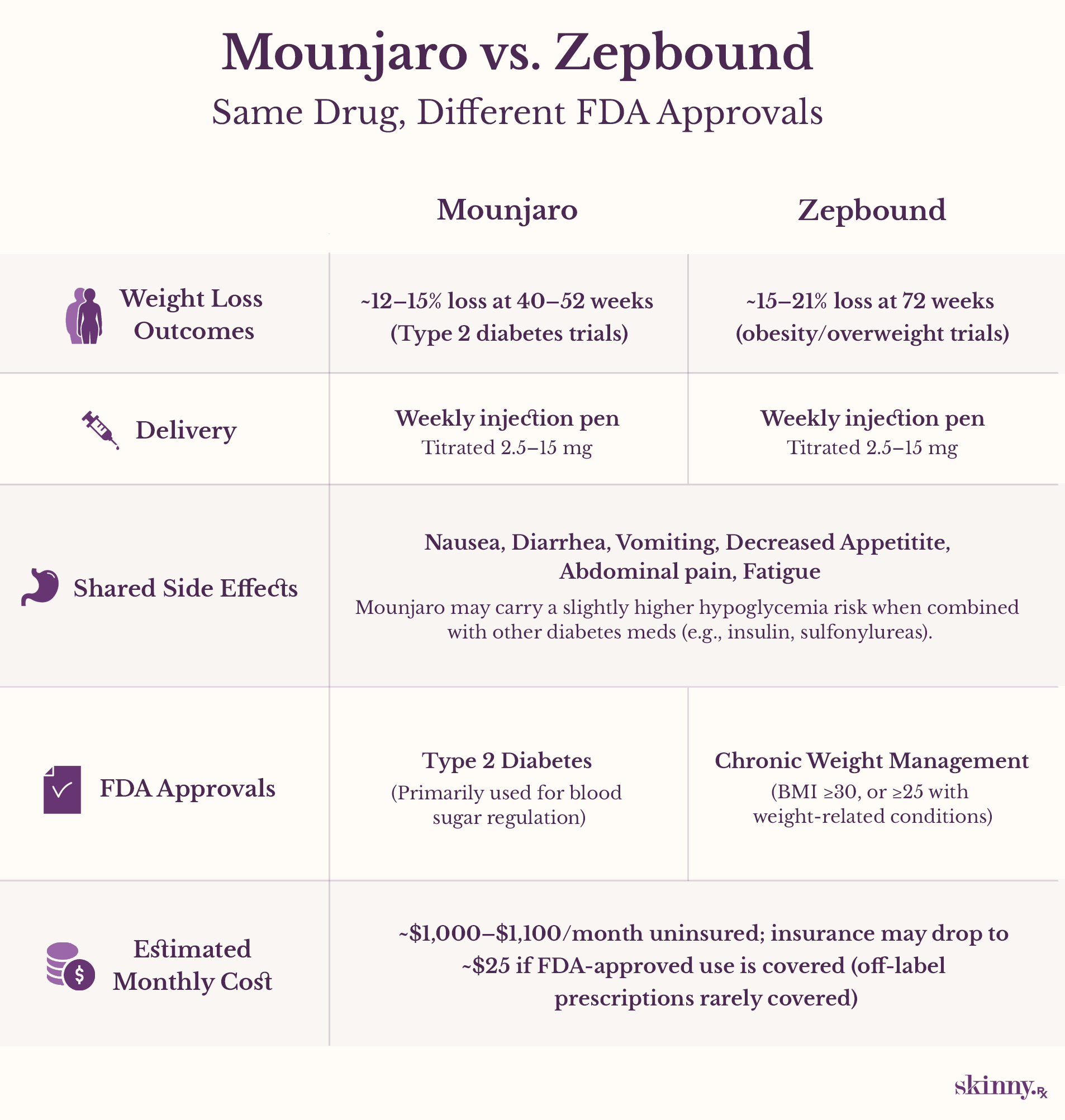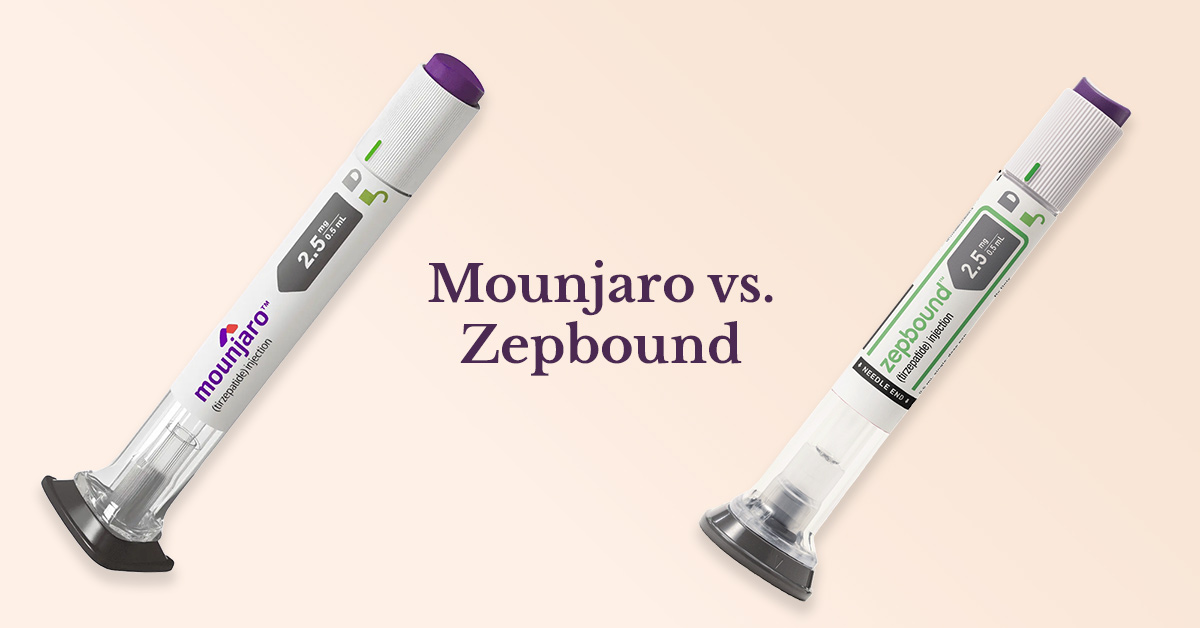
Key Takeaways
- Mounjaro and Zepbound are the same drug (tirzepatide), but FDA-approved for different conditions: diabetes vs. weight management.
- Both medications are delivered through identical weekly injection pens, with doses ranging from 2.5 mg to 15 mg.
- Side effects overlap, mostly gastrointestinal; Mounjaro users may face added hypoglycemia risk when combined with other diabetes drugs.
- Costs can exceed $1,000/month without insurance, but coverage varies—Zepbound is more often covered for weight loss, while off-label Mounjaro use usually is not.
- Clinical trials show significant weight loss: ~12–15% in diabetes patients (Mounjaro) and ~15–21% in obesity patients (Zepbound), depending on duration.
A Tale of Two Names for One Drug
Weight management medication has made tremendous leaps forward in recent years. Take Mounjaro vs. Zepbound. Both medications have the same active ingredient—tirzepatide, an injectable originally meant for the management of Type-2 diabetics that also happens to be a potent appetite regulator. But there’s a catch:
Although both brand name medications contain tirzepatide, a GLP-1 agonist, Mounjaro and Zepbound are not approved to treat the exact same conditions.
In this article, we’ll explain the ins and outs of tirzepatide on a mechanistic level and help you understand the differences between these two medications in terms of potency, prescription, and pricing.
The Science: Understanding Tirzepatide’s Dual Action
Tirzepatide is quite similar to semaglutide, the power player in industry-shakers like Ozempic and Wegovy. However, while both target the hormone GLP-1, tirzepatide also serves the dual functionality of affecting GIP, or “glucose-dependent insulinotropic polypeptide.”
By influencing both GIP and GLP-1, tirzepatide is meant to…
- Enhance blood sugar control
- Regulate appetite and augment insulin
Does that mean tirzepatide is better? Well, the jury’s out. One clinical trial from 2025 on participants with obesity (but without diabetes) concluded that tirzepatide was “superior … with respect to reduction in body weight and waist circumference.”
Research in this area is ongoing, but tirzepatide’s prospects are certainly promising so far. A 2024 meta analysis concluded that tirzepatide “could lead to remarkable and sustained weight loss that is well-tolerated and safe.”
Mounjaro vs. Zepbound: The Key FDA Distinction
Here’s the thing—the U.S. Food & Drug Administration (FDA) rigorously tests and evaluates all prescription drugs before they’re made available on the market, including the big-name brands containing semaglutide or tirzepatide.
Mounjaro and Zepbound are both manufactured by Eli Lilly. Both contain tirzepatide. But the FDA does not regard them as interchangeable.
Mounjaro for Type-2 Diabetes
Mounjaro is FDA-approved solely for the treatment of type 2 diabetes. According to manufacturer Lilly’s website, “Mounjaro … works differently [than other diabetes medications] by directly activating GIP and GLP-1 pathways to help regulate blood sugar.”
Zepbound for Weight Management
Zepbound is FDA-approved for weight loss as of 2023. Specifically, in adult patients with a BMI at or above 30 (the benchmark for obesity), or over 25 (the marker for being overweight), and who have a related medical condition (think hypertension or sleep apnea).
Why the distinction?: Although the medications are close cousins, the FDA requires separate submissions for different uses (diabetes management and weight loss). Lilly chose to seek FDA approval for tirzepatide under a new name, Zepbound.

Dosing, Administration, and Side Effects
While similar, you should be aware of the nuances that exist between Mounjaro and Zepbound.
Are the Side Effects Different?
The actual prescribing information for Mounjaro highlights some of its noteworthy side effects, including “recent major changes” such as “severe gastrointestinal adverse reactions,” among others:
- Nausea
- Diarrhea
- Decreased appetite
- Vomiting
- Abdominal pain
- Fatigue
Importantly, since both brands contain the same active ingredient (tirzepatide), both have the same broad set of side effects. There may be small discrepancies in the prevalence of certain side effects, as Mounjaro and Zepbound are approved for different on-label uses.
Patients taking Mounjaro may be at a slightly higher risk of hypoglycemia if they’re also treating their diabetes with other medications.
As with medications containing semaglutide, tirzepatide (Mounjaro and Zepbound) mainly creates gastrointestinal side effects.
Administration
Both Mounjaro and Zepbound are administered via subcutaneous (pierced through the skin) injection once weekly via identical injection pens. They also follow the same escalation schedule—after several weeks on a starting dose, you may advance to anywhere from 2.5mg to 15mg.

Clarity for Your Health Goals
Answer a few questions to connect with licensed providers who can prescribe tirzepatide for safe, effective weight loss.
The Crucial Difference: Insurance Coverage and Cost
Let’s talk money. Mounjaro and Zepbound are both highly effective at treating their approved conditions, but there’s no such thing as a free lunch.
Navigating Coverage for Mounjaro vs. Zepbound
The cost of Mounjaro vs. Zepbound is a critical question, but the financial burden of these medications can vary widely based on factors such as your provider of choice and whether you have insurance.
For example, at SkinnyRx, we’re able to offer compounded tirzepatide tablets for as low as $299.99/mo if you meet certain qualifications, while self-paid tirzepatide can range from $99.00 to $1,000.00 per month.
If you have insurance, Things change dramatically. GoodRx reports that select insurers can help you reduce your payments to as little as $25.00.
One big thing: It’s possible to receive a Mounjaro prescription for the off-label purpose of weight management, but it’s highly unlikely your insurance would provide a discount in such cases.

In my experience, Mounjaro and Zepbound have been highly effective at improving blood sugar control and supporting significant weight loss. While gastrointestinal side effects can occur early on, most patients tolerate the medication well and achieve meaningful results.
–
Dr. Daniel McGee, Board-certified Family Medicine Physician
The Verdict: Which One Should You Take?
So, all told, is Mounjaro or Zepbound right for you? Both medications rely on tirzepatide to get the job done, but Eli Lilly has clearly distinguished their intended use by getting contextual FDA approval.
If you’re mainly seeking help with type-2 diabetes symptoms but are overweight or obese, you’ll probably want to go for Mounjaro.
If you’re trying to make a change to your body composition, Zepbound is your go-to. The FDA has not approved Mounjaro for weight loss, but weight changes tend to come with the territory.
As always: Nothing beats consulting directly with your trusted medical provider. They’ll have the most informed advice based on your medical history and insurance status, and can advise you on safely using tirzepatide even if you aren’t able to get a prescription.
The Future of Tirzepatide
So, where do we go from here? We seem to be entering a new era of medical breakthroughs with both semaglutide and tirzepatide.
Regarding the latter, there are ongoing clinical trials to examine tirzepatide’s applicability for other conditions—pediatric obesity, kidney disease, and more, as well as how the compound interacts with other drugs.
Everyone’s health journey is different. If you’re thinking about improving blood sugar control, working toward weight loss, or both, we at SkinnyRx can help you explore the best path forward. By answering a few questions, you’ll receive support tailored to your needs, including treatment options like semaglutide and tirzepatide.


 Medically Reviewed
Medically Reviewed



